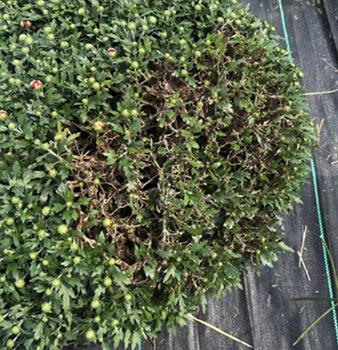Nick Flax is digging deep into a disease that’s been reported on garden mum crops recently, which has led to a bunch of calls and messages hitting his phone through the Ball Technical Services “hotline.”
PROBLEM: Reports of major Botrytis (gray mold) outbreaks in mums generally don’t hit Nick’s desk until a bit later in the season, when temperatures cool off and are consistently in the pathogen’s preferred range of about 65 to 75F (18 to 24C). But for some reason, pressure decided to come earlier than usual for mum growers this year, so we’re going to review management best practices here in Week 33.

NICK’S TIP: Don’t wait until symptoms are out of hand to act — get a jump on Botrytis now, before you find yourself fighting an uphill battle against the disease right before your plants ship!
Factors for Infection, Symptoms and Key ID Characteristics
Gray mold prefers cool to moderate temperatures and requires free water on the plant surface or high humidity to infect. Typical Botrytis symptoms and signs include:
• Chlorotic spots on leaves or stems that develop into brownish or gray necrotic lesions. Lesions may start out circular, but they become irregularly shaped as the disease progresses.
• Characteristic signs include masses of fuzzy looking, grayish clusters of spores (where the name “gray mold” comes from) growing out of infected tissue.
Be sure to scout deep in the canopy, where older leaves may have started to senesce. These dying leaves often serve as “Botrytis factories” when they remain undisturbed, tucked down near the soil surface. If left unmanaged, this dying foliage will become the source of infection for the rest of the canopy in the coming weeks.
Disease Management
Botrytis is best managed preventatively, so keep an eye on the weather, especially for your outdoor-grown mum crops. Impending rain and cool, cloudy conditions are a strong indicator that you should apply a fungicide, but here are some additional considerations for management.
• “Happy plants” reduce Botrytis pressure. Ensure that mineral nutrient levels in the soil are ample, drought stress is kept to a minimum, and plants have additional structural support (like mum netting) to discourage breakage, if needed.
• Avoid overhead irrigation whenever possible. If you must water overhead, do so early in the day and avoid watering or feeding in the late afternoon or evening. This will help to ensure the canopy is dry as nightfall approaches.
As the canopy really starts to tighten and airflow is restricted as buds set and start to develop, scout for early symptoms such as chlorosis on leaves in the middle of the “mound.”
• Clean up fallen, senesced leaves in and around your mums to reduce the number of disease reservoirs in your crop.
• This goes for foliage that may have been damaged by the elements/extreme weather AND leaves that have started to senesce naturally due to shading-out by newer growth in the upper canopy.
Keep your mums’ growing media from remaining saturated for extended periods. Water that evaporates from the soil surface can cause relative humidity in the canopy to remain high for extended periods, especially when plant spacing is tight. Restricted airflow in the lower part of the canopy often makes this worse, so it’s very important to avoid overwatering at this stage in the crop cycle.
• It’s important to ensure plants with developing buds don’t experience severe drought stress. However, you MUST balance the crop’s need for water with BMPs to reduce Botrytis pressure.
• Target a soil moisture level 4 (on the 1 to 5 scale; 1 = air dry, 5 = saturated) on the high end and allow plants to dry down to a level 2 before you water or feed again.
• Maintaining thorough wet-to-dry cycles while avoiding drought stress will help to reduce Botrytis AND rootzone disease pressure (ex. Pythium). Hitting these targets can be tricky, depending on the weather, but it’s well worth the effort.
Not all fungicides are equivalent, with respect to their efficacy. Check out this MSU Extension article from a few years ago with info on which active ingredients control Botrytis best.
• Utilize fungicides with a good spreader-sticker (like Daconil WeatherStik) to help ensure good coverage, deep canopy penetration, and staying power of the active during periods of persistent rains.
• Strobilurins (FRAC 11 fungicides) are effective preventatives for Botrytis, but do not apply these to your crop multiple times in a row, to reduce the chances of resistance development. Also, be aware that many strobilurins can discolor flowers, so be cautious if you need to treat a crop that is starting to show color. Test FRAC 11 fungicides on a small group of plants with open blooms before you treat the entire crop, or time your application to be done just before first color.
• Similarly, while chlorothalonil is highly effective at controlling Botrytis, it can discolor flowers. Other fungicides may leave residue on the foliage, which may be unappealing to customers at retail. Be sure to read the label and know of any potential risks of discoloration or residues before applying.
Check out more timely tips here, and be sure to browse our ever-growing library of technical documents, production guidelines and published plant culture.